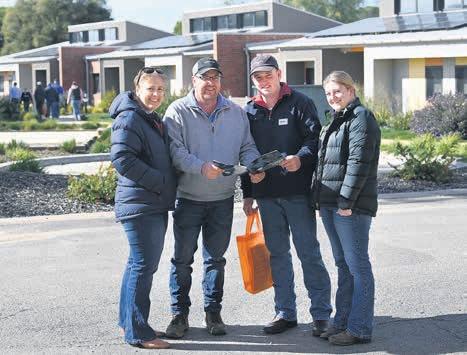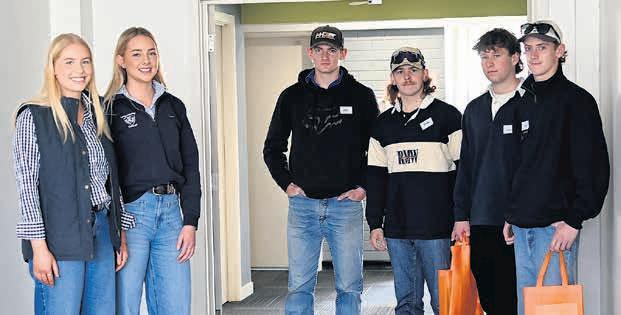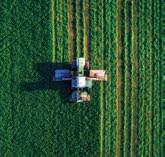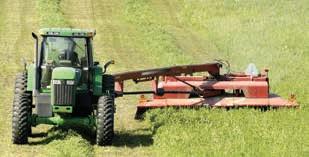
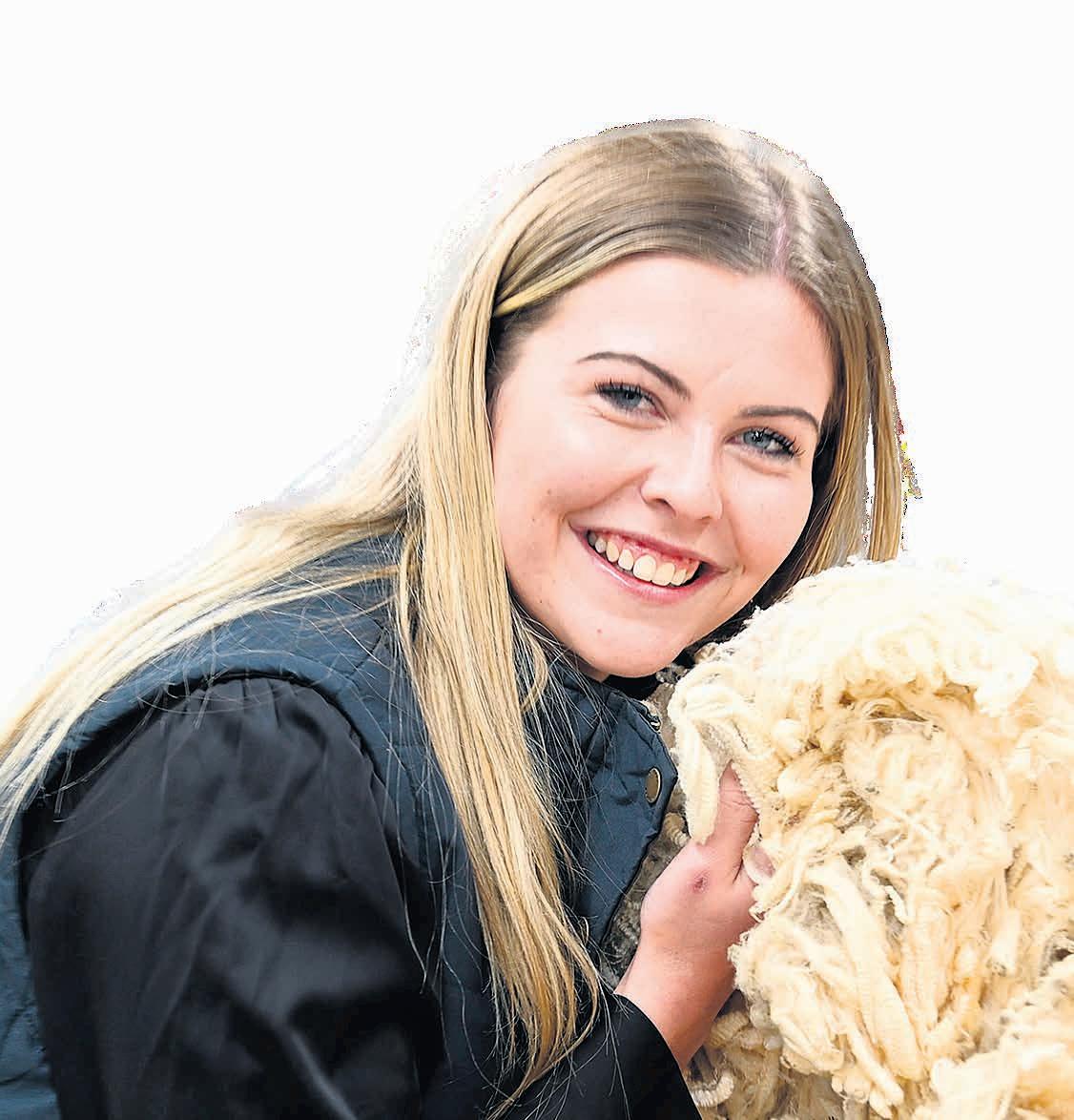
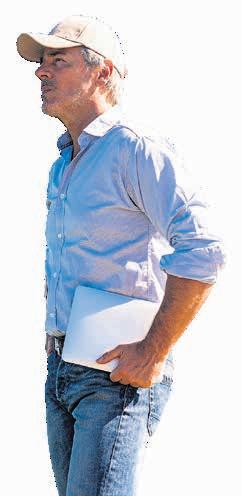

Longerenong College student Katy Pollard showcased

Picture: PAUL CARRACHER







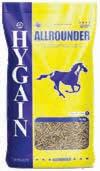





























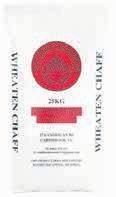







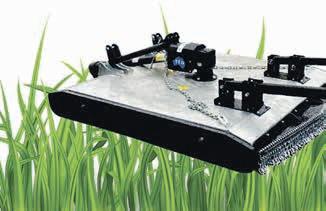

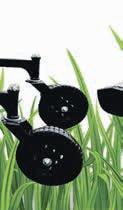






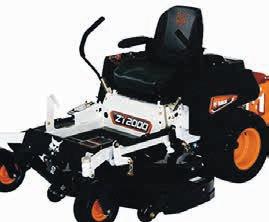



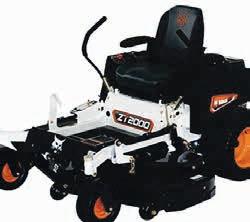







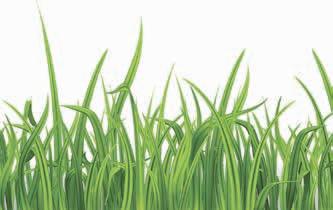






















Longerenong College student Katy Pollard showcased

Picture: PAUL CARRACHER




















































































BY BRONWYN HASTINGS
Hay producer Johnson’s is celebrating 30 years of operation and continued expansion in the Horsham area, with a community presentation and tour that showcased its new Dooen plant.
Now merged with a Japanese company and operating as Johnson Asahi, operations manager Russell Hier said the occasion was an opportunity to thank the hay growers, who are situated from Bordertown to Donald, to Ararat and Hopetoun.
“Thirty years is a long time, it’s a celebration of being at Horsham, but it’s to thank the growers more than anything,” he said.
Production moved to the first of two sheds at Dooen about three years ago, with the Horsham site closing about 12 months ago.
“It’s all been moved out here now, and we’ve changed how it works –the x-ray is now in line with production, which has been a big change,” Mr Hier said.
“The majority of the hay is then exported, with some kept for domestic use for the live cattle boats.”
Hay is transported to the site on a needs basis from storage facilities at Johnson’s depot sheds or growers’ farms, before being processed and transported via road.


The Victorian Farmers Federation, VFF, welcomed the release of the State Government’s Victorian Freight Plan 2025-30 earlier this month.
VFF president Brett Hosking described the plan as a positive step toward strengthening the state’s freight network and delivering improved outcomes for the Victorian agriculture sector.
He said the VFF appreciated the opportunity to contribute to the development of the strategy through its participation in an industry stakeholder reference group.
“Ensuring we have a fit-for-purpose freight network that delivers increased efficiency, productivity and safety is a non-negotiable and this plan must strive to deliver exactly that,” he said.
Mr Hier said there were no set amounts supplied by growers each season.
“At the end of the day, nature dictates what happens,” he said.
Serviceton farmer Leon Heinrich said he had been selling hay to Johnson Asahi for about three years, ‘for many reasons’.
“Making hay helps us clean up our paddocks,” he said.
“We have about 46 staff working 24-hour days at Dooen,” Mr Hier said. “Ideally the target is 50 staff –most of it is onsite learning, and we have skilled forklift and loader drivers and plant operators.”
“Obviously, you cut them for any weeds in your cropping paddocks, and it’s quite economic and viable for us to do so.
“Instead of letting the crop go and then trying to combat our weeds, ryegrass is the main one, we cut it and do the hay in our rotations. It works well because it helps us with the weed control and it’s pretty reasonably lucrative as well.”
Mr Heinrich, who produces fat lambs alongside cereals and legumes, said he sold sheep off early.
“We were selling the hay rather
than feeding it to the stock – it’s just a management decision we made,” he said.
“It’s just all part of the game we’re in. But the potential is there for above-average rain in Spring.”
Mr Hier said among the improvements the facility was making, was dust management.
“We’re working on a few little things to try and compress and get rid of it, we’re working on a few solutions,” he said.
“There’s always something happening here.”
“We’re particularly pleased to see initiatives aimed at improving access to and the competitiveness of the Port of Melbourne, which is essential for the export and import of agricultural products and inputs vital to farming operations. Victorian produce has never been in such demand in the global market and investment in our critical freight infrastructure will help ensure we retain our mantle as Australia’s most valuable agriculture exporting state.”
The plan outlines 58 initiatives under four key objectives.
Mr Hosking said the publication of key performance indicators to track the plan’s success would provide greater transparency and accountability, but that adequate funding would be essential and that current commitments only covered a limited number of initiatives.












BY BRONWYN HASTINGS
Planning for different futures and recovery from their outcomes, in good times and bad, was the theme of an Agriculture Victoria adaptive farming workshop led by Think Agri consultant Kate Burke at Wonwondah last week.
Dr Burke said the points of productivity, landscape, climate, people management, including self-management, and decision-making were discussed.
“It’s about how we can make better decisions, and then put together some planning tools to bring that all together,” she said.
“It’s about adaptive planning for different futures, so in good times and in bad – the main takeaway is to think about different futures and plan for each type of scenario.”
Dr Burke said the current late season presented different scenarios, such as moderate or good rainfall, and how that could impact harvesting plans.
“It’s the same with temperatures –what happens if we get a really hot day in the middle of September, and things like that,” she said.
“So just to think through scenarios and then you’re sort of ready to act if you need to.”
The profit drivers of farming were also discussed at the workshop.
“The guts of it is, and I wrote this in

a book a couple of years ago, if you’re good with production, so good with crops and livestock, good with people, and good with money, you can make money out of farming,” she said.
“But the tricky bit is you don’t always know what you’ve got until you’ve got it.
“In the good times it’s around using the surplus of those good times strate-


gically, so you’ve got something in the nest egg for the poor times, and then in the poor times it’s about taking opportunities you’ve got, but at the same time battening down the hatches so that you’re not leaking money.”
Dr Burke quoted Mark McKeon, who said that stress was not the problem, the problem was lack of recovery.
“For the young blokes playing footy,
they go and do their recovery on the Sunday morning, go and walk in the pool and whatnot, looking after their legs, we’ve got to do that with our minds and bodies as well, even if it’s just getting away for a weekend,” she said.
“We can be really hard on ourselves and we’re used to being frugal and self-sacrificing, but we’ve probably
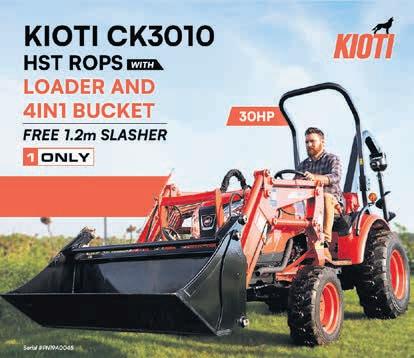
“The guts of it is, and I wrote this in a book a couple of years ago, if you’re good with production, so good with crops and livestock, good with people, and good with money, you can make money out of farming”
– Kate Burke
learnt that those stoic ways of our parents and grandparents actually don’t serve us that well.
“It’s not about blowing the budget and being silly, it’s about looking after ourselves and being kind to ourselves.”
Dr Burke said attendees appreciated the opportunity to attend the workshop and take time away from their farms.
“They could think about working on the business rather than being in the business, just to be able to have a bit of thinking time,” she said.
Dr Burke also hosted the workshop at Dunkeld on Thursday and Friday, following the Wonwondah workshops on Monday and Tuesday. People can find more information about drought support at www. agriculture.vic.gov.au/drought or call 136 186.



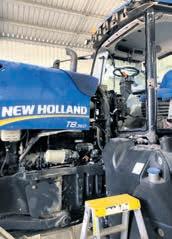

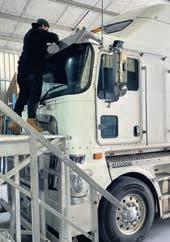





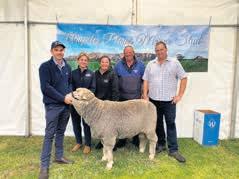












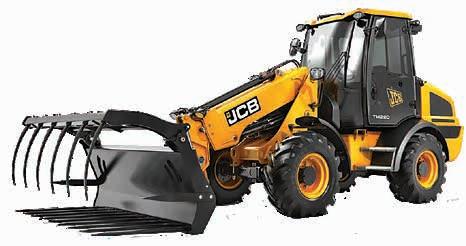

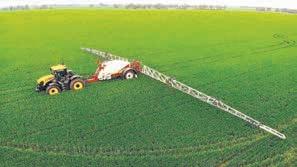


Imust confess that I was extremely sceptical when I first tripped over the concept of artificial intelligence.
Like many livestock farmers, mention AI and I’d first jump to artificial insemination. Often to my embarrassment.
Then when it was discussed as a possible way to make a reporter’s life easier, I dug my heels in. Now I must confess it has made my work as a reporter much easier.
Dr Google working hand-in-hand with AI is a beautiful thing.
Type in a few words pertinent to a topic and ‘Bob’s your uncle’, albeit not perfect every time.
My search today on Australian Wool Innovation and the breakdown of funding to 60-40 marketing and research told me Stuart McCullough was still chief executive of AWI.
Woolgrowers will know he parted company some time ago.
Where is this all leading? To a 19-year-old with his display of worker bee drones at the recent FutureAg Expo in Melbourne.
Attracted like a certain bear to honey, I was intrigued by the stand’s video display of drones spraying very hilly, largely inaccessible paddocks in Gippsland, to drones with heat sensors detecting calving cows at night, to even mustering cattle.
I shouldn’t have been so surprised.
If Ukraine can take out 40 Russian jets using smuggled drones, very much in the fashion of the Rogue Heroes TV series on the first battalion of Special Armed Forces, the possibilities are endless – if you’re into war dramas, you simply must watch Rogue Heroes.
What was the standout was that this young

with Libby Price
man had set up his own business using drones to do jobs that farmers could not.
Trying to negotiate such rugged terrain wasn’t possible on foot, let alone with tractors or ATVs.
First the drones use AI to map the topography of the country, probably the slowest part of the process.
Then the drones take flight on autopilot and do their thing.
And Ethan, the 19-year-old, has set it all up himself. I was stunned.
I’ve struggled to put together a Bunnings wheel barrow. Actually, I couldn’t put together the wheelbarrow and a friend came to the rescue.
The icing on the technology cake was when he introduced me to his Mum who was there helping him on the stand.
We gave each other that knowing ‘proud mother’ glance as I used the latest in audio technology to interview him with a tiny microphone through my mobile phone and emailed the audio to myself, all with it automatically transcribed.
Forty years ago, I was carting around a 10-kilogram reel to reel tape recorder and then racing back to the office to edit the interviews quite literally with a razor blade and sticky tape. Technology is becoming my new best friend.
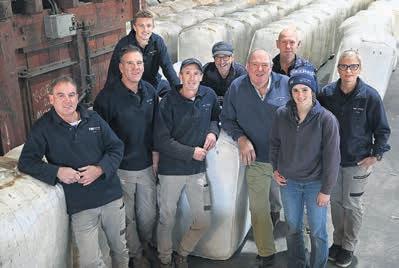


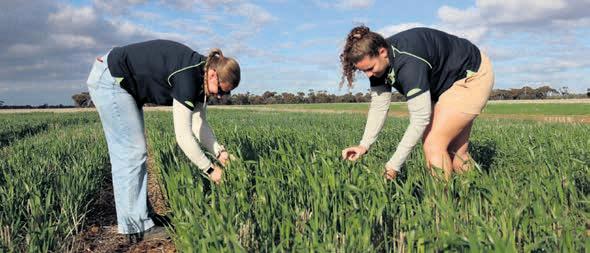
Main Field Day on September 10.
Visitors to BCG’s Main Field Day at Birchip on September 10 will have an opportunity to hear the latest on national trials of wheat and barley varieties.
BCG research agronomists
Anna Marcus and Ashlee Tierney will present an overview of Grains Research and Development Corporation’s, National Variety Trials, NVT, program.
The talk will examine how key varieties are performing under this season’s dry start, and what growers should be watching for as spring unfolds.
“There’s always an interest in what came out on top last season, and this year, we’re also taking a close look at how
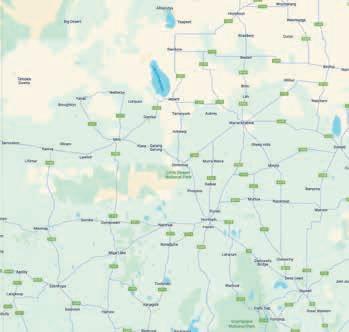

OʼBrien & Smith Lawyers are pleased to announce they have acquired Derbyshire Legal, a respected institution in Stawell. As Yvonne Derbyshire steps into a well-earned retirement, O’Brien & Smith Lawyers are excited to continue Derbyshire Legal’s tradition of exceptional legal service. O’Brien & Smith Lawyers extend their heartfelt congratulations and best wishes to Yvonne on her retirement and thank her for her continued trust and support. The team O’Brien & Smith Lawyers
The team at OʼBrien and Smith Lawyers look forward to assisting with your legal needs, and are happy to announce that Helen Thomson is back from maternity leave and now accepting appointments.
To
early establishment has played out given the challenging conditions in May and June,” Ms Marcus said.
Attendees will receive updates on top-performing varieties including Shotgun, Tomahawk, Brumby and Rockstar, as well as barley standouts Compass, Neo and Combat.
With no significant disease pressure so far this season,
BCG officials said the focus would be on growth, yield potential and agronomic performance.
Ms Tierney said growers could also get an early look at new, unnamed varieties in the pipeline.
Ms Marcus and Ms Tierney will be joined by plant breeders and local agronomists for an interactive discussion covering varietal traits, herbicide tolerance groups, and how newer lines are shaping up under Mallee conditions.
Growers are encouraged to ask questions and take advantage of an opportunity to talk directly with researchers, breeders and agronomists. For more information, people can visit bcg.org.au.
“This year we’ve included two new barley lines. One is an IMI-tolerant variety from Intergrain suited to low rainfall environments, and the other is a herbicide tolerant line for low rainfall conditions from AGT,” she said.

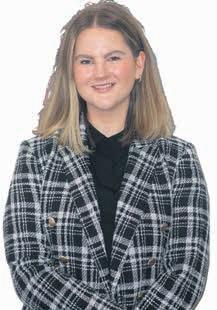
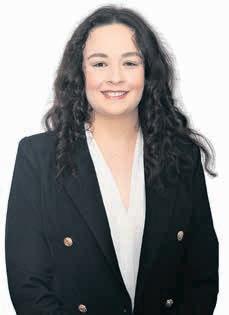
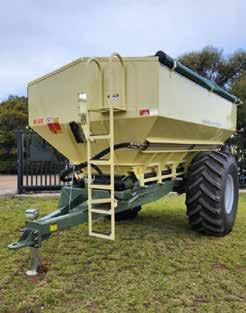



10 to 40 cubic metre capacity.
Single or Twin Augers. Front Door or Side Doors with 3 9 ft elevators.
Quick and effective mixing, complete and rapid emptying. Efficient large curved, carbide-insert knives.
Also Available: The “ heavy duty everything” range of




For 60 years the heart of the RENN Roller Mill has been its precision- machined 16” diameter rolls, which provide more grain rolling area per revolution compared to other brands of roller mills with smaller diameter rolls. Save time and money year after year by rolling more grain per hour with less horsepower.
Handles both Dry and High Moisture Rolling PTO or Electric - with Folding Discharge Augers

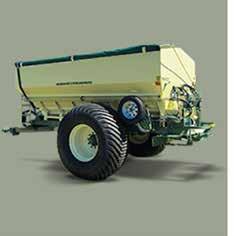





Also available: RENN GRAIN BAGGERS & BAG UNLOADER SYSTEMS




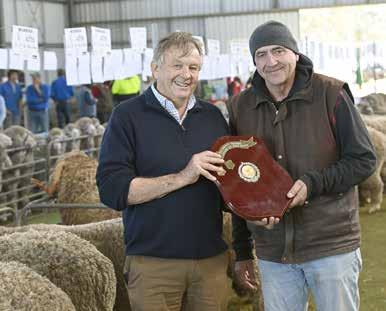
Glenelg Regional Merino Field Day at Balmoral sold 76 of its offered 96 rams, with a top price of $8000 for Stud Park South Merinos.
Field day president Warren Russell said a similar number of rams were offered at the event last year.
“We had a good line-up of rams, the crowd might be a bit lighter than normal, which is probably understandable for the season,” he said.
“Prices seem to be going okay, but it’s important to get your product out so people can see it, so grassroots sheep breeders and wool growers can come and see what’s available locally.”
Several studs participated in the event, with an average sale price of $2246.
Stud Park South sold two of four, with a top of $8000 and an average of $6250; Glenera North poll six of six, $6500, $3375; Kevlyn 19 of 19, $6500, $2750; Kurra Wirra five of five, $4250, $2550; Glenpaen four of four, $4000, $3000;
Rockbank south two of two, $3509, $2750; Mount Yulong six of six, $3000, 2000; Wurrook two of three, $2500, $2250; Melrose two of five, $2250, $2125; Gleneden 11 of 14, $2250, $1522 Gringegalgona 14 of 20, $2000, $1285; with Kalena Poll nil of four, and Glendonald and Orrie Cowie both nil of two.
Mr Russell said prizes were awarded to the topsellers – the best group of sale rams was won by Craig Eagle of Glenera North for the first time.
“The champion long wool sale ram was won by Glenpaen and the reserve was Melrose, the champion short wool sale ram was won by Stud Park South, with the reserve Glenera North. It was a very good night for Craig Eagle,” he said.
Mr Eagle, who farms south of Horsham, said he took 10 sheep to the event, and was pleased to be awarded.
“I’m very happy – it was good to get recognised for my work. For the season, they’re really good,” he said.









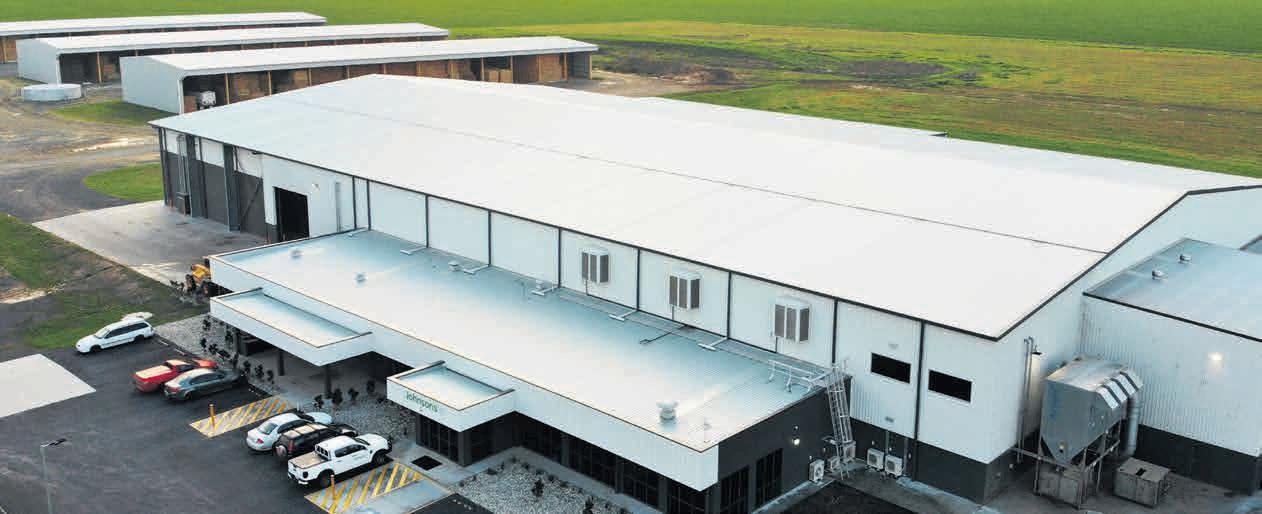


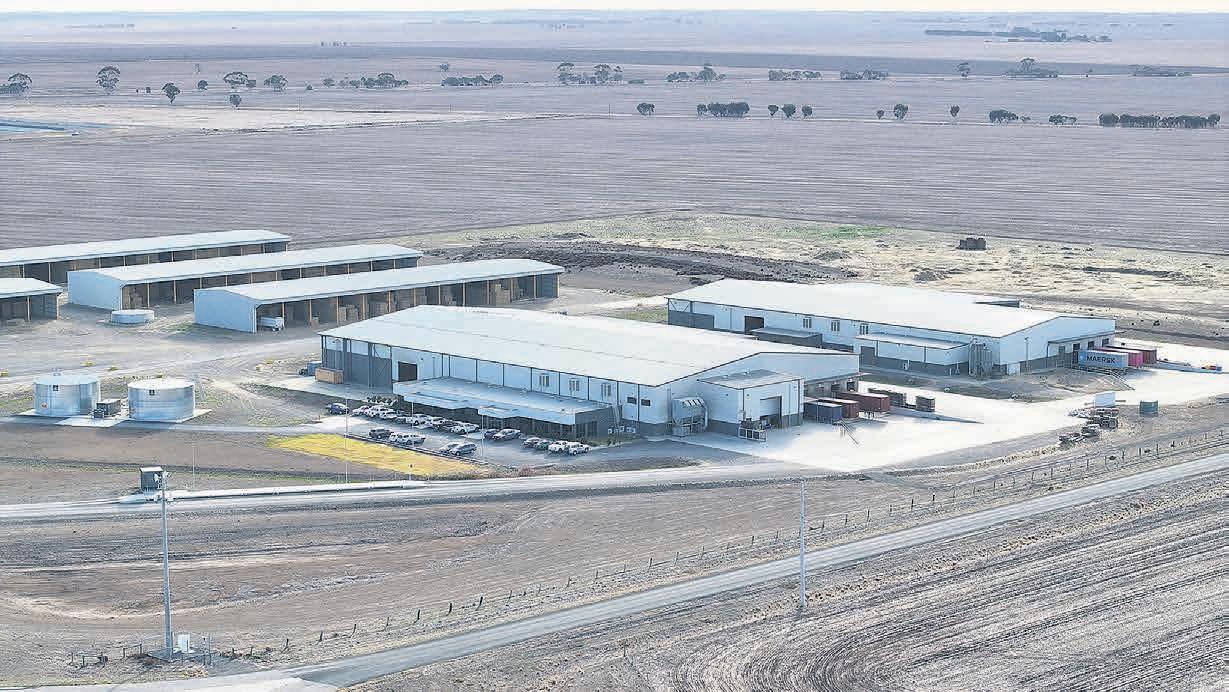








BY BRONWYN HASTINGS
Longerenong College’s new year enrolments have ‘delighted’ staff, with an overwhelming amount of interest in its agricultural courses following its annual open day.
College marketing and business development co-ordinator Brad Barber said about 40 students had already enrolled.
“We had some fantastic conversations during the open day and have been really pleased with the response since,” he said.
“There is a lot more choice now and we’re trying to give students a bit more of what they want.
“We are adjusting our courses to suit what we’re seeing in the industry, and what the industry wants from graduates.”
Mr Barber said students could ‘mix and match’ to study two courses each year, taking in the college’s agronomy, agribusiness, and wool classing qualifications.
“We expanded on our displays this year, with agronomists in the agronomy rooms, wool classers in the wool classing room, and we had
one of the trainers with our drones in the technology room,” he said.
“We had a lot more interactive displays where students and their parents could come and talk to the trainers and get an understanding of how the students learn on campus.”
A jump-on, jump-off bus toured groups to show steers, an historical display, partner RAGT’s on-site greenhouse, and the college’s agribusiness centre.
“We set up stations where prospective students could speak with current students about courses, scholarships and apprenticeships, finance, and generally living and studying at Longerenong,”
Mr Barber said.
“We had students doing walking tours as well, which took in the on-campus living and dining areas.”
Mr Barber said the open day was a culmination of a number of touch points, after meeting some of the applicants at career expos and field days.
“Prospective students are excited, but by the end of the day, parents are getting excited because they can see the potential for their children as well,” he said.


ing
This year studying Certificate IV in
ture
Certificate IV
